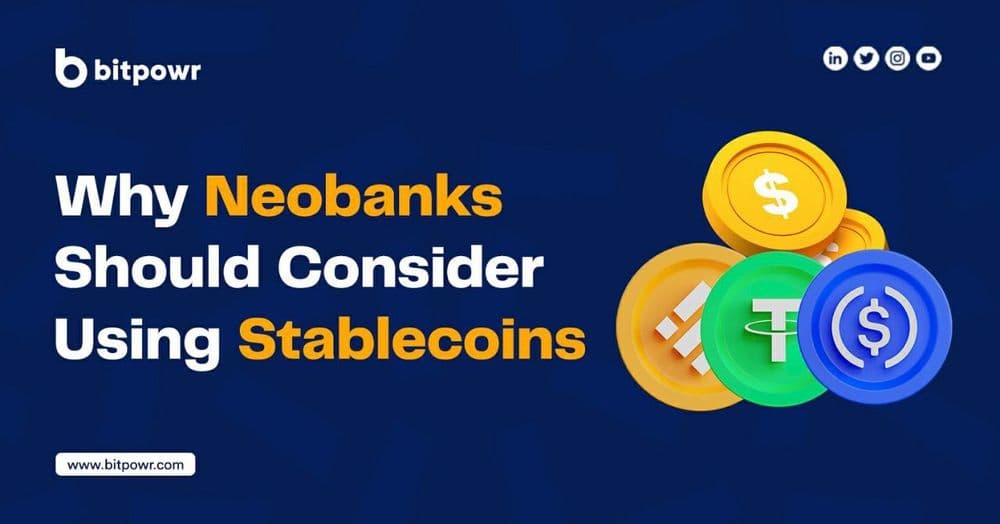The face of banking is changing globally with the rise of non-traditional banking platforms that are taking a digital-first approach. These platforms called digital banks or neobanks are marked by their flexibility and ability to deliver financial services faster and at more affordable costs, reach more people easily and lower typical barriers to accessing financial services. In essence, neobanks seek to do what traditional banks do better, faster and for more people.
So far, neobanks have been able to introduce top solutions driving financial inclusion across the world mainly because of their courage to innovate and take advantage of the latest technology. To stay true to these values, these new-age financial institutions need to consider integrating stablecoins into their operations.
If you’re wondering what stablecoins are and the benefits they offer to neobanks, you’ve come to the right place for answers.
What are Stablecoins?
Stablecoins are cryptocurrencies that are designed to maintain a stable value, often by being pegged to a stable asset or a group of assets. The goal of a stablecoin is to provide the benefits of a cryptocurrency, such as decentralization and fast transaction times, while avoiding the volatility that is often associated with cryptocurrencies. This can make stablecoins useful for a variety of purposes, including making transactions, storing value, and providing a stable means of exchange.
Types of Stablecoins
There are several types of stablecoins, each with its own unique characteristics. Some common types of stablecoins include:
1. Fiat-collateralized stablecoins: which are backed by a reserve of fiat currency, such as the US dollar. Examples of fiat-collateralized stablecoins include Tether (USDT) and USDC.
2. Cryptocurrency-collateralized stablecoins:, which are backed by a reserve of another cryptocurrency, such as Bitcoin or Ethereum.
3. Non-collateralized stablecoins: which are not backed by any specific asset but instead maintain their value through a variety of mechanisms, such as algorithmically adjusting their supply. Examples of non-collateralized stablecoins include Ampleforth (AMPL) and Synthetix Network Token (SNX).
4. Algorithmic stablecoins: which are a type of non-collateralized stablecoin that use algorithms to manage their supply and maintain their value.
It’s important to note that the viability and stability of different stablecoins can vary, and it’s always a good idea to thoroughly research any stablecoin before using it.
Advantages of Stablecoins to Neobanks
Neobanks, or digital-only banks, may find stablecoins to be useful for a variety of reasons. Some potential benefits of using stablecoins for neobanks include:
1. Faster and cheaper transactions
Since stablecoins are built on blockchain technology, they can enable faster and cheaper transactions than traditional bank transfers. This can be especially useful for neobanks, which may not have the same access to existing payment infrastructure as traditional banks. This can be especially useful for cross-border payments, which can take several days to process using traditional methods.
2. Enhanced liquidity
Stablecoins can provide an additional source of liquidity for neobanks, especially in times of market volatility or economic uncertainty. This can help neobanks to maintain stability and continue providing financial services to their customers.
3. Increased accessibility
Neobanks that use stablecoins can potentially reach a wider audience, as stablecoins can be used by anyone with an internet connection. This can be particularly useful for neobanks that operate in regions where traditional financial infrastructure is limited or unreliable.
4. Reduced volatility
One of the main advantages of stablecoins is that they are designed to maintain a stable value, often pegged to a specific fiat currency like the US dollar. This can help reduce volatility in the value of a neobank’s assets, as the value of stablecoin will remain relatively stable.
5. Greater security
Stablecoins can also provide enhanced security and fraud prevention compared to traditional banking systems. This can help to protect both neobanks and their customers from financial fraud and other security threats.
Final Thoughts
Consumers are demanding faster and more affordable transactions and banking services and neobanks’ agility and openness to adopting the latest technology perfectly place them to meet these needs. Stablecoins are an example of such technology that every financial institution looking to future-proof its operations should consider experimenting with.
At Bitpowr, we provide all financial institutions, including neobanks with access to blockchain infrastructure that enables them to securely explore cryptocurrencies and stablecoins with ease and speed. Are you building a financial services firm of the future? Come talk to us!




